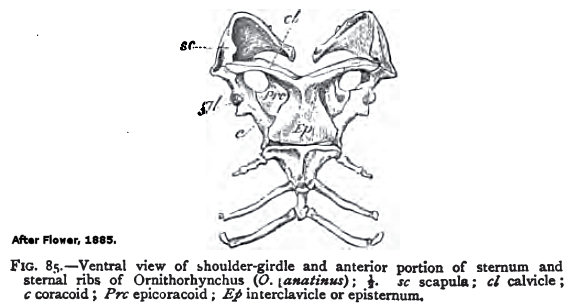The prototherians are the egg-laying mammals, the survivors of a phylogenetic line that must have branched early from the line leading to other living mammalian groups. All living forms are limited to the Australian Biogeographic Region (essentially New Guinea and Australia, including Tasmania).
Traditionally, one order, Monotremata, is recognized. McKenna and Bell (1967) recognize two, however: Order Platypoda (the Platypus, Ornithorhynchus anatinus, Family Ornithorhynchidae) and Order Tachyglossa (Echidnas, with one family and two genera of one species each), noting, probably correctly, that the two groups are not closely related. Prototherian fossils before the Pleistocene are rare, but recently have been recovered from the Lower Cretaceous of Australia and the Paleocene of Argentina (if necessary, refresh your memory of the geologic timescale).
Pictures of the platypus and echidnas can be found on the University of Michigan's Museum of Zoology website, Animal Diversity Web, as can skeletal photographs (click on "Specimens" on the site).
The Platypus is semiaquatic, semifossorial ,and carnivorous, feeding on such foods as aquatic invertebrates, frogs, and small fish. Burows are constructed in stream banks. The echidnas (often called Spiny Anteaters) are good burrowers and feed largely on insects such as ants.
The Platypus has poorly developed teeth embryonically (apparently 0/5, 1/1 (?1/2), 2/2, and 3/3). DP1/1 apparently forms. The teeth are lost early and the molars replaced by horny pads that are used to grind up food. Litter size is small, generally limited to two. The echidnas have no teeth, embryonic or later (absence of teeth is widespread in ant and termite specialists). Among the soft-anatomy features of interest is the pliable, superficially duck-like, rostrum of the Platypus, well endowed with sensory structures, including those able to sense electrical fields (and thus the muscle contractions of prey), and the spines of the echidnas. The Platypus also has a poison spur in the ankle region. The echidnas have an ephemeral pouch for the eggs and young; the Platypus does not.
 In their skeletons, the monotremes (so-called
because they preserve a reptile-like cloaca with essentially a single opening) show some characteristics that we normally think of as reptilian or otherwise unknown in mammals, including cervical
ribs ossified separately from the vertebrae and only later fusing, absence of vertebral epiphyses (except in the caudal vertebrae of the Platypus), no zygapophyses on the neck vertebrae, an
extended period of time before the odontoid process becomes fused with the axis, presence of an interclavicle, a separate coracoid, a separate epicoracoid in front of the
coracoid, and an absence of the scapula blade in front of the scapula spine. The skull lacks an alisphenoid, but has a bone homologous with the reptilian ectopterygoid. Epipubic bones are present.
In their skeletons, the monotremes (so-called
because they preserve a reptile-like cloaca with essentially a single opening) show some characteristics that we normally think of as reptilian or otherwise unknown in mammals, including cervical
ribs ossified separately from the vertebrae and only later fusing, absence of vertebral epiphyses (except in the caudal vertebrae of the Platypus), no zygapophyses on the neck vertebrae, an
extended period of time before the odontoid process becomes fused with the axis, presence of an interclavicle, a separate coracoid, a separate epicoracoid in front of the
coracoid, and an absence of the scapula blade in front of the scapula spine. The skull lacks an alisphenoid, but has a bone homologous with the reptilian ectopterygoid. Epipubic bones are present.
The second label down on the left of the figure is somewhat obscured, but denotes the glenoid fossa, the socket for the upper arm bone (humerus). The figure is from Flower, 1885, obtained through Google Book Search.
Last Update: 11 Jul 2014: classification link updated
Centennial Museum and Department of Biological Sciences, The University of Texas at El Paso